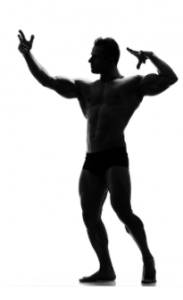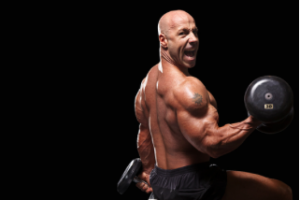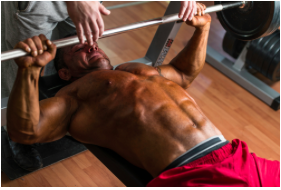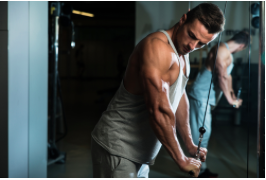The Essentials of Bodypart Specialization: Chest Training
Let’s face it – seeking out the right information can be confusing whether you are a bodybuilder or just an ...

Let’s face it – seeking out the right information can be confusing whether you are a bodybuilder or just an ...
Question: “Will taking simple carbs after a workout negate the effect of growth hormone production from your workout and kill ...
The problem with body fat is that when you start to accumulate it in large quantities (more than 20lbs), it ...
Despite our muscle gains and the conditioning we are able to achieve, many of us remain unhappy with our physical ...
We’ve all been there. You’re in the gym busting your ass everyday, your diet is on point and you’re making ...
A common nutrition plan we use with clients involves rotating low carb days with higher carb days. Low carb days ...
What if I told you that most exercise does not cause long term weight loss? This is a secret the ...
Of the major neurotransmitters, acetylcholine just might be the most important from a muscle building standpoint. As a major neurotransmitter ...
In this eye-opening article, Ben gives a breakdown of what cardio ‘actually’ is, and how the application of this newfound ...
Did you know that your body is approximately 90% bacteria and only 10% human? From birth to death, our gut ...
Are the results of your bench pressing, sore shoulders & a flat chest? Time to do things right. Here Ben ...
In preparation for writing this article, I wanted to see what exactly was written out on the web when it ...
Despite our muscle gains and the conditioning we are able to achieve, many of us remain unhappy with our physical shape. Whether we are ‘cursed’ with short biceps which we cannot seem to lengthen despite countless hours hunched over a  preacher curl bench, or high lats that refuse to be lowered even with the prioritization of movements that we are told will specifically target them, it appears that the shape of our individual muscles is immutably fixed. Although it is often assumed we can transform our physique into a scaled down version of Mr. O, we soon realize that such lofty targets are far from achievable even with the inclusion of certain exercises and the consistent application of effort. If only it was that easy. No matter how hard we try, our basic shape remains. So is it in fact possible to change the shape of our muscles? Might we enjoy better muscular symmetry and proportion with greater attention to detail in the gym?
preacher curl bench, or high lats that refuse to be lowered even with the prioritization of movements that we are told will specifically target them, it appears that the shape of our individual muscles is immutably fixed. Although it is often assumed we can transform our physique into a scaled down version of Mr. O, we soon realize that such lofty targets are far from achievable even with the inclusion of certain exercises and the consistent application of effort. If only it was that easy. No matter how hard we try, our basic shape remains. So is it in fact possible to change the shape of our muscles? Might we enjoy better muscular symmetry and proportion with greater attention to detail in the gym?
If we were able to target specific areas of a muscle so as to improve its overall shape (for example: to lower our high calves and lats, lengthen our lateral triceps, and increase the size of the vastus medialis of our lower thigh relative to its surrounding muscles) all of the top bodybuilding champions would be perfectly symmetrical and proportionate with no apparent weaknesses. With the sophisticated training methods they employ and, most importantly of all, the genetic foundation upon which their formidable size and shape is built, surely these competitors would have figured out a way to address the shape of certain weaker areas. Yet one look at any Olympia or Arnold Classic lineup will tell a different story: here you will see a diverse array of physiques – some with high calves and lats, many with short biceps and few with perfect symmetry.
Photos of top ranked pro bodybuilders in their formative competition years will show essentially the same physique, albeit a much smaller version. So, at least anecdotally it would be safe to conclude that the immutability of our muscle shape may dictate our competitive success. After all, if we could change our shape, a great many more of us would be challenging for pro titles. Indeed, the common denominator among those who fail to make the bodybuilding cut is suboptimal muscular proportion and symmetry: how our muscles complement one another and how muscularly well-balanced we are. But surely if only we could specifically stress a certain region of each muscle group, we could flesh out this particular area to, if not change its shape, at least develop enough size to close the distance?
Shapeshifting
Though many have tried, none have succeeded in changing the shape of their muscles; so much so that countless training experts have concluded that ‘shaping exercises’ such as preacher curls for the lower biceps and concentration curls for our  biceps peak are bogus and should instead be considered additional building movements, much like the multi joint exercises we use to increase a muscle’s overall size. Of the intricate network of approximately 700 individual muscles that overlap and which comprise roughly half of our bodyweight, each contains a genetically predetermined number of muscle fibers, the distribution of which creates the shape our muscles will ultimately adopt. Though our muscles can be forced to grow, or, due to insufficient overload, atrophy, their natural shape cannot be changed. Granted we may emphasize certain movements and employ a range of additional training strategies to target specific areas of a muscle (controversial in its own right), we cannot increase, or decrease, a muscle’s inherent fiber composition.
biceps peak are bogus and should instead be considered additional building movements, much like the multi joint exercises we use to increase a muscle’s overall size. Of the intricate network of approximately 700 individual muscles that overlap and which comprise roughly half of our bodyweight, each contains a genetically predetermined number of muscle fibers, the distribution of which creates the shape our muscles will ultimately adopt. Though our muscles can be forced to grow, or, due to insufficient overload, atrophy, their natural shape cannot be changed. Granted we may emphasize certain movements and employ a range of additional training strategies to target specific areas of a muscle (controversial in its own right), we cannot increase, or decrease, a muscle’s inherent fiber composition.
We have all seen top pro bodybuilding champions with ‘short’ biceps development (Golden Era training buddies Arnold Schwarzenegger and Franco Columbu can both be cited here), suggestive of longer biceps tendons. Then there are those with fully loaded guns, Sergio Oliva (to honor another old school legend) being one notable case. In contrast, Sergio’s biceps tendons were comparatively short. There is no rhyme or reason other than the genetic luck of the draw to explain why certain individuals possesses long, full muscles while others struggle to fill the gaps. But there is hope for those who have failed to hit the genetic jackpot.
Can we alter our muscle building genetics?
Short of surgery, implants or synthol (none of which this article advises), we cannot change the shape of our muscles. Our muscle building genetics are fixed at birth; thus, we cannot alter our muscle fiber composition. We can however maximize  our genetic propensity for muscle growth and significantly enhance the appearance of certain weaker muscle groupings through specificity of training and improved conditioning. There is a divergence of thought in terms of whether we may selectively recruit specific areas of muscle to improve muscle shape. The predominant school suggests that we cannot change the shape of our muscles by doing different exercises; that we can only increase a muscle’s overall size thereby allowing its natural shape to fully emerge as a result.
our genetic propensity for muscle growth and significantly enhance the appearance of certain weaker muscle groupings through specificity of training and improved conditioning. There is a divergence of thought in terms of whether we may selectively recruit specific areas of muscle to improve muscle shape. The predominant school suggests that we cannot change the shape of our muscles by doing different exercises; that we can only increase a muscle’s overall size thereby allowing its natural shape to fully emerge as a result.
It is thought that by including specific ‘shaping’ movements in an attempt to compartmentalize skeletal muscle into sections which, in turn, can be addressed sequentially, we may in fact stimulate the entire muscle from origin through to insertion. However, by rectifying shape deficiencies in such a way, we may run the risk of hindering recovery (as four or more separate movements may need to be employed in one session to hit the various parts of a muscle).
Muscle fibers (whichever area they comprise: pecs, biceps, lats and everything in between) will, when linked together, either contract fully, or not at all. So it is often recommended that we pick 2-3 movements which allow the most forceful contraction and which are biomechanically best-suited to our individual leverage requirements and become progressively stronger and more technically adept on these. If, for example, our lower lats are lagging, some consider it is best to hit the whole back region with ‘key mass builders’ such as pull-ups and bent rows; over time, once full development has occurred, this disparity should become less. By fully developing a muscle we may convey an illusion that our weaker areas have been addressed when, in reality, our natural strengths, further emphasized, have detracted from what were at first glaring deficiencies. Here, the natural shape of a muscle has not changed, but the larger size of this muscle (combined with superior definition) has helped to mask any weaknesses. One example to illustrate the role mass building movements can play in developing all-round muscular density and the importance of genetics when seeking complete development, is that of a powerlifter, who is fully developed through the entire physique, despite a training focus limited primarily to benches, squats and deadlifts. Contrast this with the typical hard-gainer bodybuilder who cannot bring up his weak lower appendages regardless of how many squats, leg extensions, leg presses and lunges he does.
On the other hand however, we have proponents of regional hypertrophy (which states that we may selectively recruit different parts of a muscle via exercise selection and overload) who argue that an individual muscle cannot simply be described as a grouping of muscle fibers that run from origin to insertion; that a muscle may be divided into several distinct segments depending on how it is activated by our nervous system’s response to resistance. Besides the number of muscle fibers we are gifted with at birth, is our composition of fiber types (slow twitch and fast twitch type IIA and IIB), which influence the extent to which we may preferentially target specific areas of a muscle. All muscles are comprised of a certain ratio of both fast and slow twitch fibers, both of which are to be fully developed to encourage overall muscle gains. However, it is the fast twitch type (larger, faster and quicker to contract) which lead to the most growth.
Because both fiber types are randomly included within a given muscle, it is thought that we have the ability to isolate a specific fiber type, the end result being non-uniform hypertrophy across a specific muscle group. Hitting a muscle from different angles may therefore ensure we hit all the fast twitch fibers concentrated in a specific area. To this end, the high intensity lifting of heavy weights with an emphasis on heavy negatives will stimulate maximal fast twitch fiber growth.
 In addition to such fast twitch fiber activation, is the notion that different parts of a muscle can be enlisted depending on the specific actions expected of that muscle. For example, an overhead triceps extension with either dumbbells or barbell, while working the all three triceps heads, will preferentially call into play the triceps long head to provide the stability needed to keep the weight skyward. The trapezius, as another example, can be targeted with three different kinds of movements to emphasize the recruitment of their upper, middle and lower portions (shrugs, rows and lat pulldowns preferentially work these areas respectively); while it is correct to say that any one trap movement will work the entire trapezius region, certain specific exercises will predominantly activate the fibers that are needed to complete this movement’s action, while ensuring the correct movement pattern is established and maintained throughout. So while changing a muscle’s shape may not be possible, it is important to note the inherent complexity and malleability of muscle tissue; that it is more than just an assortment of fibers attached to bone and which produce movement.
In addition to such fast twitch fiber activation, is the notion that different parts of a muscle can be enlisted depending on the specific actions expected of that muscle. For example, an overhead triceps extension with either dumbbells or barbell, while working the all three triceps heads, will preferentially call into play the triceps long head to provide the stability needed to keep the weight skyward. The trapezius, as another example, can be targeted with three different kinds of movements to emphasize the recruitment of their upper, middle and lower portions (shrugs, rows and lat pulldowns preferentially work these areas respectively); while it is correct to say that any one trap movement will work the entire trapezius region, certain specific exercises will predominantly activate the fibers that are needed to complete this movement’s action, while ensuring the correct movement pattern is established and maintained throughout. So while changing a muscle’s shape may not be possible, it is important to note the inherent complexity and malleability of muscle tissue; that it is more than just an assortment of fibers attached to bone and which produce movement.
The unique differences within muscle groupings and fibers (variations in size, metabolic efficiency, protein composition, and, as mentioned, muscle fiber distribution) all influence the extent to which they are likely to respond to resistance training and any success we might have in correcting weaker areas. Different parts of a muscle may be forced to grow larger and become stronger depending on our posture, limb positioning and the range of motion of an exercise. Indeed, electromyographic activity (EMG) data has shown that by varying an exercise, we can alter the recruitment of certain fibers within an entire muscle. This regional recruitment of muscle fibers may allow us to target certain areas of a weaker grouping to address proportion, symmetry and overall size (but not genetic shape). Such malleability of muscle appears to govern the site specific recruitment of individual fibers.
However, try explaining this to the seasoned competitor who simply cannot develop their upper pecs to match their lower chest, despite repeatedly emphasizing upper pec stimulation. So while varying exercise selection may optimize muscle growth in specific areas, it may also at times be a case of an individual’s natural potential being fully realized.
Closing the distance
Radically transforming the appearance of our muscles can most certainly be achieved by increasing their size, degree of definition, proportion and symmetry. However, once achieved, what we are left with is a supersized version of our former selves, complete with our natural shape, based on the number of muscle fibers we were born with. All bodybuilding  physiques, from amateur to professional, are uniquely shaped; some are close to symmetrically perfect, while others have glaring weaknesses. Most are deficient in some area.
physiques, from amateur to professional, are uniquely shaped; some are close to symmetrically perfect, while others have glaring weaknesses. Most are deficient in some area.
While we may be able to selectively recruit certain areas of a muscle to fully maximize the development of these regions, it is a mistake to conclude that we can completely change a muscle’s shape. Indeed, if this were the case, would not every aspiring physique champ possess perfect symmetry? Could we not simply target through certain key movements any physical weakness so as to remedy a lack of proportion or symmetry? This can be done to a degree by training all of our muscles with optimal intensity and fully tapping our growth potential. But our natural shape cannot be altered. You cannot defeat your genetics; but you can make the most of them!
References
Kawakami, Y. T., Abe, S., Kuno, Y. & Fukunaga, T. Training-Induced Changes in Muscle Architecture and Specific Tension. Eur. J. Appl.Physiol. 72: 37-43 1995
Meija, M. Made to Order Muscle; can you really change the shape of a muscle? [Online] http://www.t-nation.com/free_online_article/sports_body_training_performance/made_to_order_muscle retrieved on 18.10.14
Muscle Building Shortcuts. The Role of Genetics in Muscle Building (and What to do if You’re a Hardgainer). [Online] http://www.musclebuildingshortcuts.com/mind-strength/the-role-of-genetics-in-muscle-building-and-what-to-do-if-youre-a-hardgainer retrieved on 18.10.14
Narici, M.V., Hoppeler, H., Kayser, B., Landoni, L., Claasen, H., Gavardi, C., Conti, M., & Cerretelli, P. Human quadriceps cross-sectional area, torque, and neural activation during 6 months of strength training. Acta Physiol, Scand. 157: 175-186 1996.
Sarti, M. A., Monofort, M. S., Fuster, M. S., & Villaplana, M. D. Muscle activity in the upper and lower rectus abdominus during abdominal exercises. Arch. Phys. Med. Rehab. 77: 1293-1297. 1996